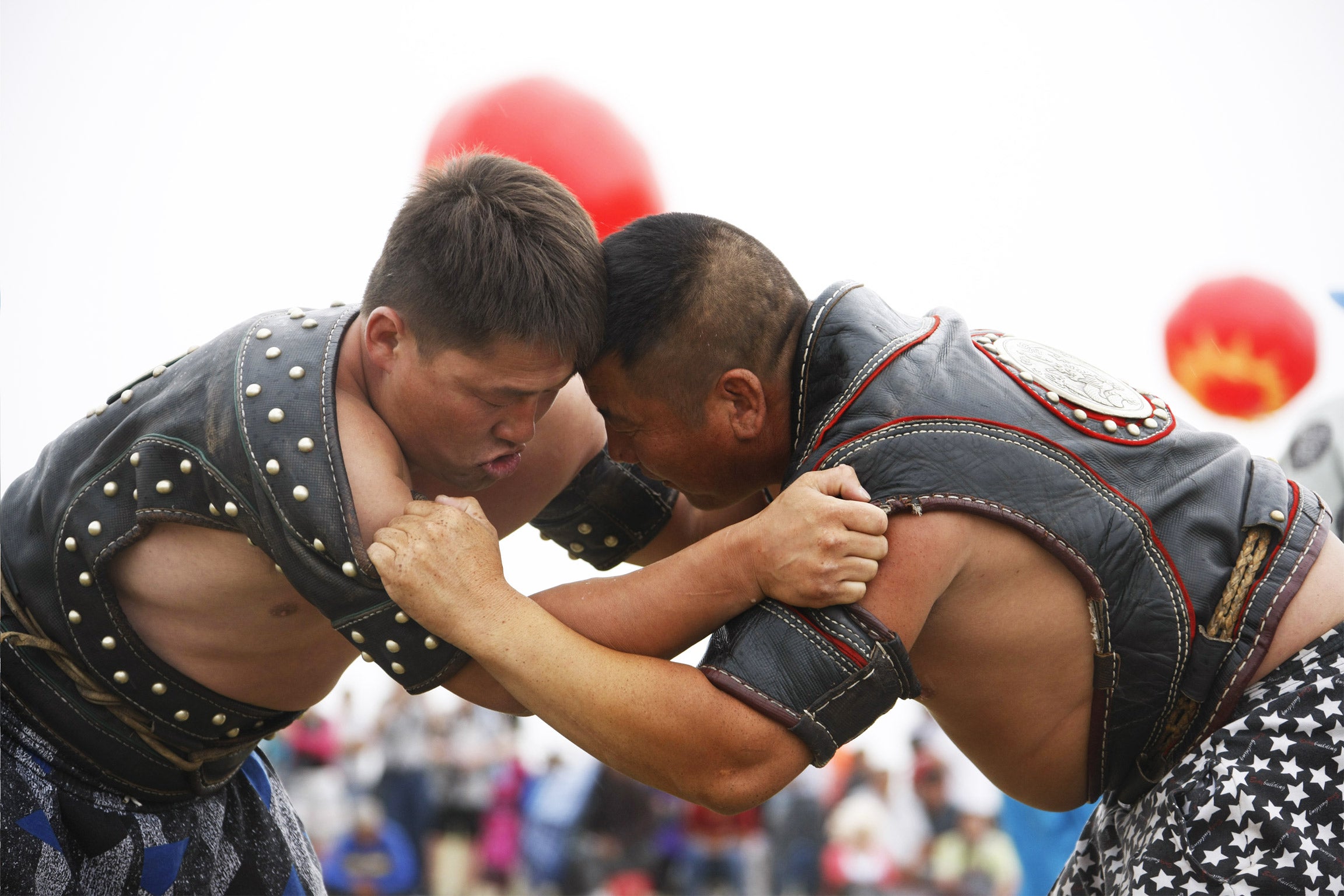Grunt and grapple: Mongolia’s passion for wrestling fights off lures of booming economy
Ancient cave paintings depict two men grappling with one another in front of a crowd - in a scene still frequent today

In a bare, stony field in the middle of the Gobi desert dozens of men in tight-fitting briefs and open-shirted tunics slap their thighs and eye each other up. In the tiny hamlet of Shinejinst, the annual Mongolian wrestling competition is about to begin.
Wrestling has been a part of Mongolian life for centuries. Cave paintings depict two men grappling with one another in front of a crowd. Nine thousand years later, Mongolia is one of the world’s fasting growing economies but when it comes to wrestling not that much has changed. Every July, in villages, towns, and cities across this vast central Asian state, wrestlers compete in the Naadam “the games”.
On the edge of the wrestling field in Shinejinst, Khatnaa Chuluun awaits his first bout. Last year, Khatnaa a broad-shouldered 21-year-old was knocked out in the second last round of the Naadam. This time around he is hoping to go one better.
“I think I can do it,” says Khatnaa as the opening pairs of wrestlers lock arms. A large crowd rings the arena. Some have walked only a few hundred metres from the nearby houses and traditional tents. Others have driven for miles to sit and watch the action from the comfort of their expensive 4x4s. Almost everyone is wrapped up in brightly coloured, long flowing deels coats.
This mix of ancient and modern is typical of contemporary Mongolia. A decade-long mineral boom has transformed one of the most sparsely populated countries on the planet, bringing with it double-digit growth and Western-style lifestyles.
Many former nomads have sold their livestock and swapped the steppe for the city. Almost half of Mongolian’s population of three mllion now live in the capital Ulan Bator, where the affluent can shop in Louis Vuitton and Swarovski and work in glass-fronted offices.
Wrestling, however, remains a national obsession. Conservative estimates put the numbers of active wrestlers in the country at around 30,000. Many, such as Khatnaa, live in the capital but compete in their home provinces hundreds – or even thousands – of miles away.
Khatnaa’s opening bow has come. His body is bronzed and toned, the product of weeks of training at a specialist pre-Naadam training camp.
His first opponent looks less seasoned. He is tall and thin and wears jeans instead of the customary figure-hugging shuudag shorts. Both men are amateurs but from the opening exchange it is clear who has the edge in strength and guile. Khatnaa grabs his opponent by the shoulders and pulls him to the floor. The crowd clap politely.
The national Naadam, held in the middle of July in the capital, is the biggest event in the Mongolian calendar. Thousands of paying spectators and dignitaries flock to the national stadium. Shinejinst is a far more local affair. There are no posters advertising global brands, or concession stands, no hawkers selling traditional Mongolian fried dumplings or sunglasses.
Wrestling is, in some ways, more than a sport in Mongolia. Increasingly success in the ring is a gateway into politics and business. Many famous wrestlers have held high office since the democratic revolution replaced the world’s second oldest Communist regime in 1990. Many more have become phenomenally rich.
Khatnaa, like many young Mongolians, dreams of such wealth. He lives with his wife and young child in Ulan Bator, where he works as a physical education teacher. But he wants to leave the classroom behind, to set out in the import-export business. “There is more money in that,“ he says.
At the Naadam, Khatnaa continues his fine form, casually dispensing with one challenger after another in the crowded wrestling field where, as custom dictates, bouts take place simultaneously. Within an hour, 128 competitors have been whittled down to just eight.
The pace slackens. Khatnaa has been grappling with his opponent for ten minutes, feeling his way around for an opening. Their bodes twist one way, then another. “Hurry up, hurry up,” shouts an aged man in a cowboy hat and a purple deel from the sidelines. Almost instantaneously Khatnaa hits the deck.
Khatnaa’s Naadam is over. He walks back to his car, a look of real surprise on his face. He swears loudly, in English. The drive back home to Ulaanbaatar will take a day and a night. It will feel even longer.
‘Wrestling with Modernity’, Peter Geoghegan’s documentary about Mongolian wrestling, is on BBC Radio 4 at 11am on Monday.
Join our commenting forum
Join thought-provoking conversations, follow other Independent readers and see their replies
Comments